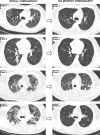Follow-up after acute respiratory distress syndrome caused by influenza a (H1N1) virus infection
- PMID: 21808854
- PMCID: PMC3129942
- DOI: 10.1590/s1807-59322011000600002
Follow-up after acute respiratory distress syndrome caused by influenza a (H1N1) virus infection
Abstract
Background: There are no reports on the long-term follow-up of patients with swine-origin influenza A virus infection that progressed to acute respiratory distress syndrome.
Methods: Four patients were prospectively followed up with pulmonary function tests and high-resolution computed tomography for six months after admission to an intensive care unit.
Results: Pulmonary function test results assessed two months after admission to the intensive care unit showed reduced forced vital capacity in all patients and low diffusion capacity for carbon monoxide in two patients. At six months, pulmonary function test results were available for three patients. Two patients continued to have a restrictive pattern, and none of the patients presented with abnormal diffusion capacity for carbon monoxide. All of them had a diffuse ground-glass pattern on high-resolution computed tomography that improved after six months.
Conclusions: Despite the marked severity of lung disease at admission, patients with acute respiratory distress syndrome caused by swine-origin influenza A virus infection presented a late but substantial recovery over six months of follow-up.
Figures
Similar articles
-
Recovery of pulmonary functions, exercise capacity, and quality of life after pulmonary rehabilitation in survivors of ARDS due to severe influenza A (H1N1) pneumonitis.Influenza Other Respir Viruses. 2018 Sep;12(5):643-648. doi: 10.1111/irv.12566. Epub 2018 Jun 12. Influenza Other Respir Viruses. 2018. PMID: 29676537 Free PMC article.
-
Influenza-induced acute respiratory distress syndrome during the 2010-2016 seasons: bacterial co-infections and outcomes by virus type and subtype.Clin Microbiol Infect. 2020 Jul;26(7):947.e1-947.e4. doi: 10.1016/j.cmi.2020.03.010. Epub 2020 Mar 20. Clin Microbiol Infect. 2020. PMID: 32205296
-
Organizing pneumonia in patients with severe respiratory failure due to novel A (H1N1) influenza.BMJ Case Rep. 2010 Jul 21;2010:bcr0220102708. doi: 10.1136/bcr.02.2010.2708. BMJ Case Rep. 2010. PMID: 22767562 Free PMC article.
-
Influenza and endemic viral pneumonia.Crit Care Clin. 2013 Oct;29(4):1069-86. doi: 10.1016/j.ccc.2013.06.003. Crit Care Clin. 2013. PMID: 24094391 Free PMC article. Review.
-
Influenza A(H1N1)pdm09-related pneumonia and other complications.Enferm Infecc Microbiol Clin. 2012 Oct;30 Suppl 4:43-8. doi: 10.1016/S0213-005X(12)70104-0. Enferm Infecc Microbiol Clin. 2012. PMID: 23116792 Free PMC article. Review.
Cited by
-
Pneumological research in Clinics.Clinics (Sao Paulo). 2012 Nov;67(11):1237-40. doi: 10.6061/clinics/2012(11)02. Clinics (Sao Paulo). 2012. PMID: 23184196 Free PMC article. No abstract available.
-
Pulmonary sequelae in a patient recovered from swine flu.Lung India. 2012 Jul;29(3):277-9. doi: 10.4103/0970-2113.99118. Lung India. 2012. PMID: 22919170 Free PMC article.
-
Efficacy of lung recruitment maneuver with high-level positive end-expiratory pressure in patients with influenza-associated acute respiratory distress: a single-center prospective study.Curr Ther Res Clin Exp. 2013 Dec;75:83-7. doi: 10.1016/j.curtheres.2013.10.001. Curr Ther Res Clin Exp. 2013. PMID: 24465049 Free PMC article.
-
Resolved Influenza A Virus Infection Has Extended Effects on Lung Homeostasis and Attenuates Allergic Airway Inflammation in a Mouse Model.Microorganisms. 2020 Nov 27;8(12):1878. doi: 10.3390/microorganisms8121878. Microorganisms. 2020. PMID: 33260910 Free PMC article.
-
Long-term changes in pulmonary function among patients surviving to COVID-19 pneumonia.Infection. 2022 Aug;50(4):1019-1022. doi: 10.1007/s15010-021-01718-2. Epub 2021 Oct 15. Infection. 2022. PMID: 34652626 Free PMC article.
References
-
- World Health Organization. Transmission dynamics and impact of pandemic influenza A (H1N1) 2009 virus. Wkly Epidemiol Rec. 2009;46:481–4. - PubMed
-
- Hui DS, Lee N, Chan PKS. Clinical management of pandemic (H1N1) infection. Chest. 2010;137:916–25. 10.1378/chest.09-2344 - DOI - PMC - PubMed
-
- Estenssoro E, Rios FG, Apezteguia C, Reina R, Neira J, Ceraso DH,, et al. Pandemic 2009 influenza A (H1N1) in Argentina: A study of 337 patients on mechanical ventilation. Am J Respir Crit Care Med. 2010;182:41–8. 10.1164/201001-0037OC - DOI - PubMed
-
- Miller RR, Markewitz BA, Rolfs RT, Brown SM, Dascomb KK, Grissom CK,, et al. Clinical findings and demographic factors associated with ICU admission in Utah due to novel 2009 influenza A (H1N1) infection. Chest. 2010;137:752–8. 10.1378/chest.09-2517 - DOI - PMC - PubMed
-
- Cui W, Zhao H, Lu H, Wen Y, Zhou Y, Deng B, et al. Factors associated with dead in hospitalized pneumonia patients with 2009 H1N1 influenza in Shenyang, China. BMC Infect Dis. 2010;10:1–9. 10.1186/1471-2334-10-145 - DOI - PMC - PubMed
Publication types
MeSH terms
LinkOut - more resources
Full Text Sources
Medical


